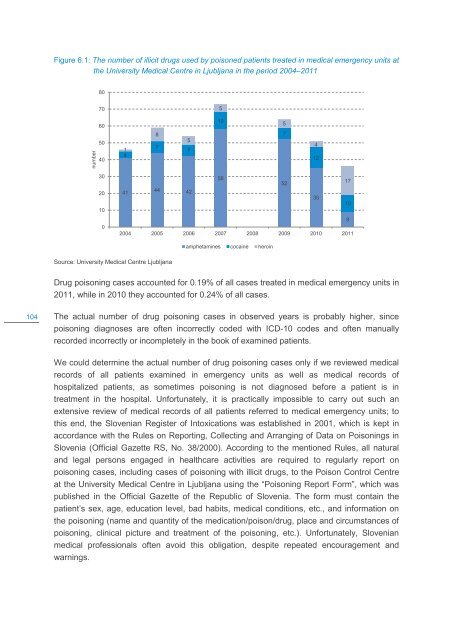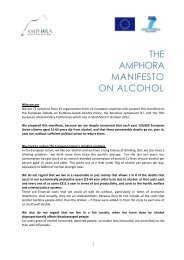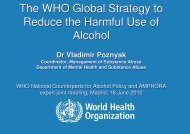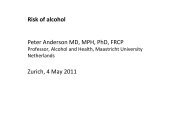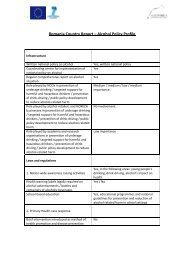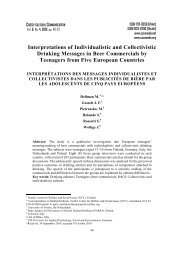Figure 6.1: The number of illicit drugs used by poisoned patients treated in medical emergency units atthe University Medical Centre in Ljubljana in the period 2004–201180705number605040148757105741230201005852174144 42351092004 2005 2006 2007 2008 2009 2010 2011amphetamines cocaine heroinSource: University Medical Centre LjubljanaDrug poisoning cases accounted for 0.19% of all cases treated in medical emergency units in2011, while in 2010 they accounted for 0.24% of all cases.104The actual number of drug poisoning cases in observed years is probably higher, sincepoisoning diagnoses are often incorrectly coded with ICD-10 codes and often manuallyrecorded incorrectly or incompletely in the book of examined patients.We could determine the actual number of drug poisoning cases only if we reviewed medicalrecords of all patients examined in emergency units as well as medical records ofhospitalized patients, as sometimes poisoning is not diagnosed before a patient is intreatment in the hospital. Unfortunately, it is practically impossible to carry out such anextensive review of medical records of all patients referred to medical emergency units; tothis end, the Slovenian Register of Intoxications was established in 2001, which is kept inaccordance with the Rules on Reporting, Collecting and Arranging of Data on Poisonings inSlovenia (Official Gazette RS, No. 38/2000). According to the mentioned Rules, all naturaland legal persons engaged in healthcare activities are required to regularly report onpoisoning cases, including cases of poisoning with illicit drugs, to the Poison Control Centreat the University Medical Centre in Ljubljana using the “Poisoning Report Form”, which waspublished in the Official Gazette of the Republic of Slovenia. The form must contain thepatient’s sex, age, education level, bad habits, medical conditions, etc., and information onthe poisoning (name and quantity of the medication/poison/drug, place and circumstances ofpoisoning, clinical picture and treatment of the poisoning, etc.). Unfortunately, Slovenianmedical professionals often avoid this obligation, despite repeated encouragement andwarnings.
In conclusion, we can say that emergency examinations of persons poisoned with illicit drugsaccount for at least 0.20% of all patients examined in medical emergency units in Ljubljana,and that the number of combined poisonings, especially with amphetamines, is increasing,while the number of heroine poisonings is decreasing.6.3 Drug-related deaths and mortality of drug usersJožica Šelb ŠemerlDrug-related deaths are a phenomenon that belongs, like other addictions, in the field ofpublic health; it concerns young people starting an independent life, that means people whohave not yet started or have just started to live their own lives. In theory, the mentionedphenomenon could be prevented completely, or at least decreased through preventiveactions.Because death and causes of death are only final consequences of the effects of internaland external factors which lead to death at a certain age, we have to pay attention to asmany those factors as possible, namely factors that are involved in the process of illicit druguse and the occurrence of drug-related health problems. On the basis of causes of death wecan retrospectively determine the risk factors for diseases or health problems which finallyled to death. In order to be able to prevent drug related deaths, we have to determine howmany of them in a certain population group are involved in drug use, and learn about thebasic epidemiological characteristics and time trends of the phenomena.105This chapter presents mortality due to direct effects of drugs in the body in Slovenia in 2011,the evolution of direct drug-related deaths in the period 2004–2011, and mortality in a cohortof patients in treatment for illicit drug addiction, which were followed up during the period2004–2011.Drug-related deaths have been monitored in Slovenia in accordance with the EMCDDArecommendations since 2003. Monitoring data includes:• direct drug-related deaths, i.e. deaths of people who died due to direct effects of illicitdrugs in the body: such data, i.e. data on the underlying cause of death, are obtainedfrom the Mortality Database (IVZ 46: Medical Report on the Deceased Person);• indirect drug-related deaths, i.e. data on those people who died due to indirect effects ofillicit drugs on their health, where drug effects were a secondary cause of death; suchdata are cohort study data.To determine the number of indirect drug-related deaths, we analysed demographic andother data collected at the Death Certificate and Civil Report on the Cause of Death - theDEM-2 form. Deaths were analysed according to basic epidemiological indicators, andmortality rates were calculated as deaths per 1,000 person years in an individual populationgroup. To calculate the mortality rate in the Slovenian population, we used the number ofdeaths and the number of inhabitants in 2007; for age standardization, the Europeanstandard population was used. We also calculated excess mortality in drug users compared
- Page 3 and 4:
2012 NATIONAL REPORT (2011 data) TO
- Page 7 and 8:
SUMMARYChapter 1Amendments to the C
- Page 9 and 10:
parents, girls with associated prob
- Page 11 and 12:
elated social security programmes,
- Page 13 and 14:
Chapter 12Slovenia's gross domestic
- Page 15 and 16:
DRUG POLICY: LEGISLATION, STRATEGIE
- Page 17 and 18:
part of an addiction treatment prog
- Page 19 and 20:
In addition to coordination, the In
- Page 21 and 22:
Furthermore, the Health Insurance I
- Page 23 and 24:
The declaration also highlights the
- Page 25:
DRUG USE IN THE GENERAL POPULATION
- Page 31 and 32:
Age group comparison shows that the
- Page 33 and 34:
Field procedureData collection was
- Page 35 and 36:
Table 2.5: Lifetime use of illicit
- Page 37 and 38:
The fact that data on the prevalenc
- Page 39 and 40:
Observational visits in night venue
- Page 41 and 42:
Customer intoxication and incidents
- Page 43 and 44:
Focus groups of high-school student
- Page 45 and 46:
Figure 3.1: Excise duty per hl of e
- Page 47 and 48:
Some tobacco control measures in Sl
- Page 49 and 50:
data on the sale of these products,
- Page 51 and 52:
individual to have an (imparted) se
- Page 53 and 54: Co-creating community responses in
- Page 55 and 56: As regards the intention of student
- Page 57 and 58: according to the usual schedule dur
- Page 59 and 60: Community-based preventionAnalysis
- Page 61 and 62: programme carried out in the USA an
- Page 63 and 64: They also plan to conduct workshops
- Page 65 and 66: PROBLEM DRUG USE4.‘Problem drug u
- Page 67 and 68: (with their grandmother, brother, i
- Page 69 and 70: Almost two thirds of those who inje
- Page 71 and 72: DRUG RELATED TREATMENT: TREATMENT D
- Page 73 and 74: Social protectionProfessional activ
- Page 75 and 76: 5.2 Access to treatmentIn Slovenia,
- Page 77 and 78: Figure 5.2: Number of programme use
- Page 79 and 80: 42.9% of drug users who re-entered
- Page 81 and 82: used opiates once a week, 12 (13.5%
- Page 83 and 84: The main reason for first-time admi
- Page 85 and 86: survey results, which show that onl
- Page 87 and 88: Correlation between first-time admi
- Page 89 and 90: hepatitis B free of charge in CPTDA
- Page 91 and 92: The proportion of drug users who ha
- Page 93 and 94: Trends in the proportion of users w
- Page 95 and 96: 2. The decrease in the proportion o
- Page 97 and 98: HEALTH CORRELATES AND CONSEQUENCES6
- Page 99 and 100: on the prevalence of infections tha
- Page 101 and 102: 6.2 Other drug-related health corre
- Page 103: Table 6.3 shows the number of illic
- Page 107 and 108: In all observed years, the number o
- Page 109 and 110: Figure 6.4: Trends in the number of
- Page 111 and 112: The Obalno-kraška and the Zasavska
- Page 113 and 114: Cohort studyMortalityOnly drug user
- Page 115 and 116: CPTDAs covering the three largest S
- Page 117 and 118: drug users had been treated in othe
- Page 119 and 120: Violent deaths (V01.0 - Y98.9, F11.
- Page 121 and 122: and benzodiazepines. Three quarters
- Page 123 and 124: life than deaths of their peers (th
- Page 125 and 126: RESPONSES TO HEALTH CORRELATES ANDC
- Page 127 and 128: Low-threshold programmes include fr
- Page 129 and 130: 8.1 Social exclusion and drug useTa
- Page 131 and 132: Table 8.2: Users and capacities in
- Page 133 and 134: 9.1 Drug-related crimeStaša Šavel
- Page 135 and 136: Secondary crimeCompared to 2010, th
- Page 137 and 138: 9.2 Prevention of drug-related crim
- Page 139 and 140: Table 9.7: Number of persons having
- Page 141 and 142: Patients take substitute medicine u
- Page 143 and 144: information required for solving pr
- Page 145 and 146: groups from other countries. Most o
- Page 147 and 148: Table 10.1: Total amounts of seized
- Page 149 and 150: 10.3 Quality and purity of illicit
- Page 151 and 152: CannabisThe most common type of can
- Page 153 and 154: amounts of active components and ad
- Page 155 and 156:
Data on the purity of various illic
- Page 157 and 158:
RESIDENTIAL TREATMENT OF DRUG-USERS
- Page 159 and 160:
Photo 11.1: The old school which wa
- Page 161 and 162:
(source: Terapevtska skupnost Cenac
- Page 163 and 164:
social assistance networks is of hi
- Page 165 and 166:
schedules and through work therapy,
- Page 167 and 168:
provides drug users with medical ca
- Page 169 and 170:
programme, and draw up a report on
- Page 171 and 172:
It seems that we will have to devot
- Page 173 and 174:
Despite the absence of radical meas
- Page 175 and 176:
Purpose Funder YearAmount(EUR)Cofog
- Page 177 and 178:
that co-funding is relatively stabl
- Page 179 and 180:
Table 12.2: Drug-related expenditur
- Page 181 and 182:
12.5 ConclusionsBy 2011, the effect
- Page 183 and 184:
BIBLIOGRAPHYList of referencesAnder
- Page 185 and 186:
Klavs I, Poljak M. (2003) Unlinked
- Page 187 and 188:
SURS. (2011) Oddelek za cene življ
- Page 189 and 190:
OECD. (2012a) Country Statistical p
- Page 191 and 192:
Zakon o omejevanju porabe alkohola
- Page 193 and 194:
Table 8.2: Users and capacities in
- Page 195 and 196:
Figure 5.12: Number of first-time a


